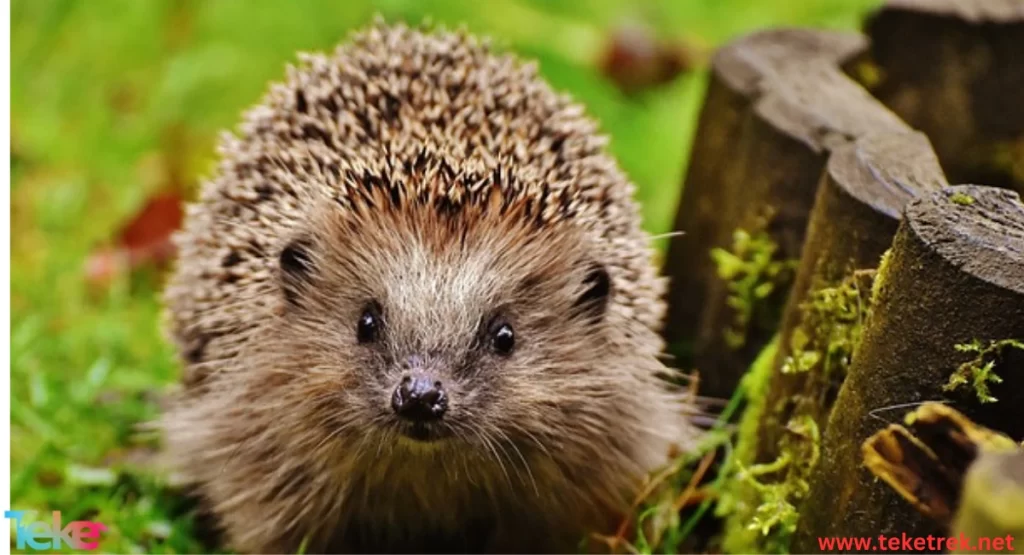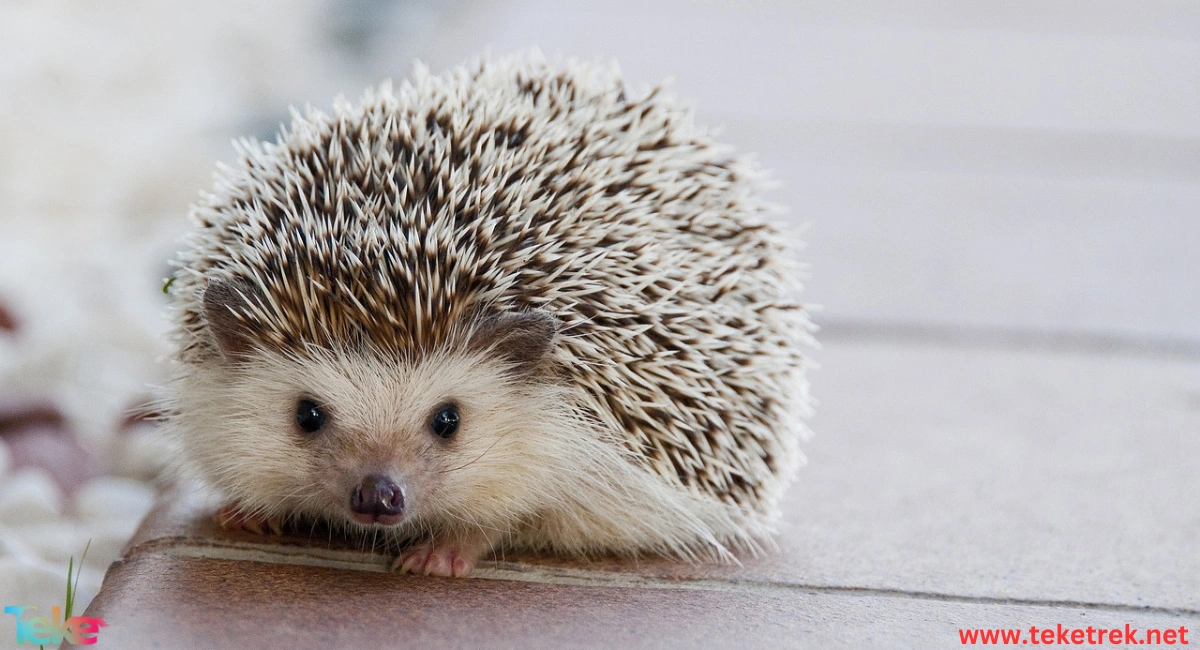The hedgehog is a small carnivorous animal belonging to the Echinacea family of mammals. It impresses many because of its beauty and uniqueness. It is considered one of the most interesting animals in the natural world. It is characterized by its body covered with sharp spines that make it look like a pointed ball. Despite its small size, it has unique features that help it survive in its wild environment.
The hedgehog is remarkable for its ability to adapt to its environment, as it can interact with various environmental and natural conditions that it faces. Starting from its ability to hide and defend itself effectively, and other wonderful adaptations that make it a unique creature worthy of attention.
In this article on TekeTrek Website, we will learn together more Information about hedgehogs and explore the secret of their special appeal, their behaviors, their distinctive features, and how they adapt to their wild environment. Let’s dive into the world of this amazing creature and discover what makes it unique among other animals.

What is a hedgehog? How does it reproduce? What are its most important types?
The hedgehog (Erinaceinae) is a small mammal that sleeps in the winter and wakes up in the spring. Hedgehogs live in a variety of habitats around the world. The hedgehog is distinguished by its independent personality and slow and deliberate movements, and it is considered one of the active nocturnal animals.
Hedgehog specifications and appearance
The hedgehog has a number of unique features and appearances, including:
1. The hedgehog is characterized by its body covered with tough, sharp spines that serve as a natural defense against predators. The colors of the thistle change from brown to dark gray depending on the species.
2. The hedgehog has a stout body and short legs. Its length is usually between 15 to 30 centimeters, and it weighs about 500 to 1000 grams.
3. The hedgehog has a sharp, close-to-the-ground nose that helps it detect food and smells.
4. The hedgehog’s ears are small and round and are located on either side of its head.
5. Hedgehog eyes are distinguished by their small size and high position on the sides of the head.
6. The hedgehog has a short, indistinct tail that blends into its body.
7. Hedgehog colors vary between brown, gray, and black, with white or white-gray spots on the body.
What does a hedgehog eat?
The hedgehog depends mainly on a carnivorous diet, and feeds mainly on insects such as caterpillars, worms, beetles, spiders, bird eggs, reptiles and small mice, in addition to that, fruits and plants.
Types of hedgehogs
- African hedgehog.
- Wild hedgehog.
- Half hedgehog.
- Medium hedgehog.
- Abyssinian hedgehog.
Hedgehog reproduction
- Mating hedgehogs annually produces 1-11 hedgehogs, and these young hedgehogs remain with their mothers for a period ranging from 4 to 7 weeks.
- The mother protects her young from predators, especially other male hedgehogs that can prey on the young of her own kind. It is also known that mothers may eat their young if the nest is disturbed.
What are the benefits of hedgehog for nature and humans?
The hedgehog plays an important role in nature and provides many benefits to the environment and humans, including:
1. Insect control:
- Hedgehogs are predators of insects such as caterpillars, worms, and other insects that cause damage to crops and plants. Therefore, the hedgehog contributes to regulating insect populations and maintaining biological balance in nature.
2. Seed transportation:
- The hedgehog is considered one of the animals that contribute to the transfer of plant seeds, as the seeds that stick to its thorns can travel with it and grow in distant places, which contributes to the spread and diversity of plants.
3. Attracting tourists:
- The hedgehog is part of nature’s biodiversity and may be a tourist attraction in the areas where it lives. Tourists may be interested in seeing this unique creature and learning about its behavior and way of life.
4. Environmental awareness:
- Hedgehogs can be a subject to raise awareness about the importance of protecting biodiversity and preserving wild animals. By informing people about the importance of the hedgehog’s role in nature, awareness of the importance of preserving the environment and preserving living creatures can be increased.
- In short, hedgehogs are an important part of the environment and provide multiple benefits to nature and humans.


How does a hedgehog protect itself from enemies?
The hedgehog has distinctive defense mechanisms that help it protect itself from enemies. Here are the most important methods that the hedgehog uses to defend itself:
- Thorns:
Thorns are a hedgehog’s main defense, as it is covered with sharp, hard thorns that act as a shield to protect it from enemies. When a hedgehog feels threatened, it stretches, braces itself, and sticks out its spines, terrifying predators.
- Stings:
In addition to the spines, the hedgehog can also release small spines under its skin called ‘stinging spines’ when it feels threatened. These spines contain a small amount of venom that can cause irritation to the skin or mucous membranes of the aggressor animal.
- Camouflage:
When a hedgehog feels threatened, it uses a camouflage strategy to protect itself from enemies. It may roll into a small ball and hide its head and limbs under its body, making it appear more solid and difficult to attack.
In these ways, the hedgehog uses various defense mechanisms to protect itself from enemies and potential threats in the environment.
Natural Enemies of the Hedgehog
Despite having sharp spines for defense, the hedgehog has several natural predators that can threaten its life. Some of these include:
- Hyenas
- Wild dogs
- Foxes
- Birds of prey
- Snakes
Hedgehog Defenses
The hedgehog possesses physical weapons, such as sharp spines on its back, which serve as effective defenses against predators. It also has the ability to curl into a tight ball when threatened, making it difficult for enemies to attack. Additionally, it can run quickly to escape danger.
Threats Facing Hedgehogs
Hedgehogs face many threats that can affect their survival and lead to endangerment. These threats include:
- Loss of natural habitat, reducing living space and food availability.
- Environmental pollution, which affects their health and contaminates air, water, and soil.
- Hunting, which can decrease population numbers and disrupt ecological balance.
- Accidents, such as road collisions, which may lead to injury or death.
- Diseases, which can cause death or reduce population size.
- Climate change, affecting food supply and environmental conditions.
- Predation, which poses a continuous threat from natural predators.
Hedgehog Life Cycle
The hedgehog’s life cycle consists of several stages, from birth to old age:
- The female gives birth to 1–7 young per litter.
- The gestation period lasts about 30–40 days.
- The young nurse for 4–6 weeks.
- During the growth phase, they rapidly develop and begin to grow spines.
- They transition to solid food and become more independent.
- They learn to forage and avoid danger.
- They reach maturity at 6–12 months and can begin reproducing.
- In the wild, hedgehogs typically live 4–7 years.
- As they age, they may become more vulnerable to disease and injury.
Do Hedgehogs Transmit Diseases?
Yes, hedgehogs can carry diseases and parasites that may affect humans and other animals. These include:
- Salmonella, a common bacterial infection that affects the digestive system.
- Tapeworms, which can affect the intestines and potentially spread to other animals or humans.
- External parasites, like ticks and fleas, which can cause skin problems and spread rapidly.
Differences Between Hedgehogs and Porcupines
While both animals have spines, hedgehogs and porcupines are very different:
| Aspect | Hedgehogs | Porcupines |
|---|---|---|
| Family | Erinaceidae | Rodentia |
| Body and Spines | Small, round bodies with short, dense spines | Larger, elongated bodies with longer, sharper spines |
| Diet | Insects, worms, fruits, and vegetables | Mainly plants and vegetation |
| Habitat | Forests, plains, gardens | Forests and rocky areas |
| Social Behavior | Solitary | Can be social and live in groups |
| Defense | Use spines for defense | Use spines for defense; can be more aggressive when threatened |
| Size | 20–30 cm | 60–90 cm |
Fun Facts About Hedgehogs
Hedgehogs are fascinating creatures. Here are some fun facts:
- They can sleep up to 16 hours a day, making them some of the longest sleepers in the animal kingdom.
- They have up to 7,000 spines on their back.
- They curl into a tight ball when threatened for protection.
- They have a strong sense of smell to help find food.
- They are beneficial to the environment due to their insectivorous diet.
- They can swim, though not expertly.
- They make various sounds, including squeaks and chirps.
Can Hedgehogs Be Kept as Pets?
Yes, raising a hedgehog at home can be fun and rewarding, but it requires commitment and proper care. Here’s a brief guide:
Basic Needs
- They need ample space to live and move—like a large cage or enclosure.
- A balanced diet rich in protein, including commercial hedgehog food, fruits, and vegetables.
- Clean, fresh water must always be available.
Health Care
- Regular checkups to monitor health.
- Vaccinations against common diseases and parasites.
- Veterinary care when ill or injured.
Hedgehogs in Culture and Mythology
Hedgehogs appear in many cultures and myths, often symbolizing patience, protection, and humility:
In Cultures:
- In some African cultures, hedgehogs symbolize patience and resilience.
- In Asian cultures, they represent protection and humility.
- In European folklore, they symbolize modesty and simplicity.
In Mythology:
- In African myths, the hedgehog is seen as a clever and cunning character.
- In Asian mythology, it is viewed as a sacred animal tied to nature and fertility.
- In European legends, it is a beloved creature linked to nature and innocence.
- The hedgehog’s spines symbolize defense, while its modest behavior reflects humility and its endurance signifies patience.
Frequently asked questions about hedgehogs?
There are many common questions and Information about hedgehogs, especially those interested in raising and keeping this adorable creature.
- Why is the hedgehog active at night?
Hedgehogs are nocturnal, which means they are active during the night and remain asleep during the day. This nocturnal activity of the hedgehog has several reasons:
Hedgehogs are nocturnal because their eyes are sensitive to bright light, so they find darkness more suitable for them.
In areas with hot weather, the night is cooler than the day, and therefore the hedgehog prefers to go out to search for food and carry out its activities during the night to avoid high temperatures.
Given that hedgehogs rely heavily on defense mechanisms that protect them from predators, being active at night helps them avoid exposure and stay safe.
Hedgehog nocturnal activity could also be related to the presence of certain predators that are active during the day, causing the hedgehog to choose night as a suitable time to forage and feed.
- What does the hedgehog’s body cover?
The hedgehog’s body is covered with hard, tough needles known as “thorns” or “spikes.”
- What is the danger of hedgehogs?
Hedgehogs’ bodies are covered with long, sharp spines that contain an amount of poison. Touching or stepping on them usually results in a painful wound.
- Does a hedgehog live at home?
Yes, the hedgehog is a pet that lives at home, as the breeding experience is an entertaining, enjoyable and relatively easy experience.
- What is the age of a hedgehog?
The lifespan of a hedgehog ranges from 2 to 5 years.
- Where does a hedgehog live?
Hedgehogs live in a variety of habitats around the world
- Where do hedgehogs live?
the hedgehogs live in many different places, desert, forest and beyond.
- What eats a hedgehog?
They eat birds of prey such like hawks and owls.






